A new New York law requires museums to label art looted by Nazis — but is it constitutional?
Some legal scholars say the law is an example of ‘compelled speech’ and may violate the First Amendment

“The Rape of Tamar,” a 17th-century painting attributed to Eustache Le Sueur, is owned by the Met. A New York Times investigation revealed in 2020 that it was likely abandoned by Siegfried Aram, a Jewish art dealer, when he fled Nazi Germany in 1933. Illustration by Samuel Breslow
When New York Gov. Kathy Hochul signed the nation’s first law requiring museums to label artworks known to have been looted by the Nazis, she hailed it as a way to honor Holocaust victims. But some legal scholars say the law, which passed unanimously in both the state Assembly and state Senate and went into effect last month, may not be constitutional.
Hundreds of thousands of artworks were stolen from Jews after the Nazis came to power in an attempt to enrich the regime and erase Jewish culture, and many have ended up in museum collections around the world — including an unknown number in New York. In recent decades, Jewish heirs of collector families have sued to try to get works back, with mixed success.
“It’s vital that we be transparent and ensure that anyone viewing artwork stolen by the Nazis understand where it came from and its role in history,” the law’s chief senate sponsor, State Sen. Anna Kaplan, a Long Island Democrat, said in a press release.
But however well-intentioned the law, multiple First Amendment lawyers said in interviews that it could be an example of “compelled speech,” which judges generally frown upon to avoid forcing anyone to say something they would rather not. Still, even if the statute can withstand judicial scrutiny, museums may have ways to sidestep it. For several reasons, scholars say, the law may amount to little more than a statement of political will.
A ‘shaming sign’
Eric Goldman, a professor at the Santa Clara University School of Law who studies compelled speech, said it was unclear how courts might interpret the measure if it were challenged.
“One way of framing the law is that it’s an incursion into the museum’s artistic decisions,” he said, in which case it could be struck down. “It tells a museum how they must present their art and that has implications for the museum’s ability to speak, to make its own artistic statement.”
But another way to view the law, he continued — that it simply requires museums to disclose the details of a work’s ownership history — could put it on more solid ground.
Goldman said it’s difficult to predict which path a judge might take because a look at prior compelled speech cases shows that “the law itself is just anarchy,” with courts applying it “in wildly inconsistent ways using a variety of tests.”
In one such case, the Supreme Court ruled in 1943 that schoolchildren cannot be forced to salute the U.S. flag or say the Pledge of Allegiance. And in 1977, it ruled that New Hampshire cannot require vehicles to use license plates with the state’s motto, “Live Free or Die.”
However, in other situations, the government has been able to make the case that it has a legitimate reason to compel speech, particularly in the commercial realm, where consumer protection laws require manufacturers to include nutrition facts or health warnings on their products.
Rebecca Tushnet, a First Amendment professor at Harvard Law School, was less ambivalent than Goldman about the law’s prospects in court.
“I don’t think it’s constitutional,” she said. “The government needs a really good reason to stop you from speaking in the way you want and to require you to say something that you would rather not say. And if you’re not a commercial seller, then it’s very rare that there’d be a good enough reason.” (The new law applies only to museums, not art galleries or auction houses.)
She noted that, because the law requires museums to provide the information “prominently” on “a placard or other signage,” rather than just in an online database, the courts may be less likely to see it as merely an ownership disclosure. “This is a shaming sign,” she said.
(New York law already requires works that were transferred during World War II to be registered with the Art Loss Register.)
Tushnet added that the government sometimes inappropriately uses compelled speech when it wants to incentivize an action, in this case restitution, but would find doing so directly too complicated or politically unpalatable. “If the government interest is not really in informing the public, it’s in getting the stuff back, then the correctly tailored law gives the stuff back,” she said.
And if New York’s interest is merely in educating museumgoers, not returning works, then courts would likely force the state to say what it wants to say directly, to avoid confusion about whether speech is coming from the museum or the government, she said. “When there are other options, like a public education campaign, courts often find that the government should have to take that path instead.”
A spokesperson for Kaplan, the bill sponsor, took issue with the idea that the law raises constitutional questions, writing to the Forward that “the legislation was vetted by the Senate’s counsel, the Assembly’s counsel, and the governor’s counsel, and at no time was an issue raised that the legislation presents any First Amendment concerns.”
Her office did not respond to further inquiry.
A law that ‘sends a message’
“Museums are unlikely to be excited about this law, because any disclosures they make in relation to the law could very well become the basis of a lawsuit against them,” Goldman said. “The potential plaintiffs would treat that as an admission that would potentially fuel their case to try and reclaim ownership of the item.”
But the law may remain safely on the books — less because of its constitutionality than because of its toothlessness. To get struck down by the courts, it would first need to reach them — and because it lacks any mechanisms for enforcement, museums may find it easier to just ignore it than to incur the expense and reputational risk of challenging it.
“Our legal codes are littered with laws that are never enforced,” said Goldman. “This was a messaging bill in my mind. This law wasn’t really meant to be law. It was really meant to send a message to voters.”
And even if New York attempts to enforce the law, its text leaves a lot of room for interpretation and evasion. It was amended during the drafting process to require the disclosure only “to the extent practicable,” which provides a loophole, Goldman said. “Museums could easily take the position, ‘it wasn’t practical for us to do this.’”
Provenance research is also inherently complicated. “It’s not necessarily like, either it was stolen by Nazis or it’s fine,” said Victoria Reed, the senior curator for provenance at the Museum of Fine Arts, Boston, and a leader in the field of restitution. “There were a lot of ways in which art was lost during this time.”
Goldman agreed. By treating an artwork’s status as a binary — looted or not — “the disclosure could potentially mislead the viewers by suggesting that there might be issues with the integrity of the ownership when in fact maybe it’s clean,” he said.
The law applies to all art “which changed hands due to theft, seizure, confiscation, forced sale or other involuntary means in Europe during the Nazi era,” which Reed noted appears to include works that were returned immediately after the war and later acquired by museums, not just those with contested ownership.
And even museums not seeking to cover up a questionable acquisition might find that the space taken up by the disclosure crowds out other educational information they’re seeking to convey. “Some of these objects are small decorative arts objects that are in cases where the space for a label is really quite limited,” said Reed. “You can’t make four points in a label. You can really make one point in a label.”
Reed noted that the American Alliance of Museums has published detailed guidance for curators about how to handle Nazi-era provenance issues and how to communicate transparently about them, but that many smaller institutions struggle to find the resources needed to conduct proper research.
The institutions that are subject to the new law, including the Metropolitan Museum of Art, the largest art museum in the Americas, have so far stayed mum about it. The Met did not provide comment to the Forward.
Separate from the new law, museums are facing mounting pressure to return looted works — and not just those stolen by Nazis. Investigators seized 27 artifacts worth more than $13 million from the Met on Sept. 2, asserting that they had been looted from Italy and Egypt.
“Museums are being held increasingly accountable to their public and to their visitors,” said Reed. “And I do think that our visitors want to know the stories, perhaps more than they did 20, 30, 40 years ago.”
The Forward is free to read, but it isn’t free to produce

I hope you appreciated this article. Before you go, I’d like to ask you to please support the Forward.
Now more than ever, American Jews need independent news they can trust, with reporting driven by truth, not ideology. We serve you, not any ideological agenda.
At a time when other newsrooms are closing or cutting back, the Forward has removed its paywall and invested additional resources to report on the ground from Israel and around the U.S. on the impact of the war, rising antisemitism and polarized discourse.
This is a great time to support independent Jewish journalism you rely on. Make a gift today!
— Rachel Fishman Feddersen, Publisher and CEO
Support our mission to tell the Jewish story fully and fairly.
Most Popular
- 1

Fast Forward Ye debuts ‘Heil Hitler’ music video that includes a sample of a Hitler speech
- 2

Opinion It looks like Israel totally underestimated Trump
- 3

Culture Cardinals are Catholic, not Jewish — so why do they all wear yarmulkes?
- 4

Fast Forward Student suspended for ‘F— the Jews’ video defends himself on antisemitic podcast
In Case You Missed It
-

Culture How one Jewish woman fought the Nazis — and helped found a new Italian republic
-

Opinion It looks like Israel totally underestimated Trump
-

Fast Forward Betar ‘almost exclusively triggered’ former student’s detention, judge says
-

Fast Forward ‘Honey, he’s had enough of you’: Trump’s Middle East moves increasingly appear to sideline Israel
-
Shop the Forward Store
100% of profits support our journalism
Republish This Story
Please read before republishing
We’re happy to make this story available to republish for free, unless it originated with JTA, Haaretz or another publication (as indicated on the article) and as long as you follow our guidelines.
You must comply with the following:
- Credit the Forward
- Retain our pixel
- Preserve our canonical link in Google search
- Add a noindex tag in Google search
See our full guidelines for more information, and this guide for detail about canonical URLs.
To republish, copy the HTML by clicking on the yellow button to the right; it includes our tracking pixel, all paragraph styles and hyperlinks, the author byline and credit to the Forward. It does not include images; to avoid copyright violations, you must add them manually, following our guidelines. Please email us at [email protected], subject line “republish,” with any questions or to let us know what stories you’re picking up.















